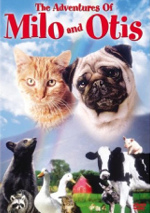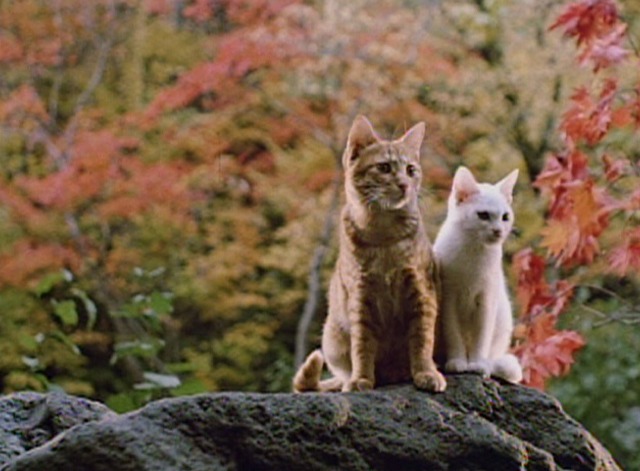
English language version: The Adventures of Milo and Otis
Fuji Television Network
Narrators: Shigeru Tsuyuki (Japanese), Dudley Moore (English language)
Directed by: Masanori Hata
Synopsis: The Japanese title translates literally to “A Kitten’s Story.” The Japanese version of the film follows the life of Chatran, an orange tabby kitten born on a farm and his pug dog friend Poosky. One day Chatran is whisked down a river in a wooden box and Poosky chases after him, leading to some exciting and perilous adventures for them both. The American version follows the misadventures of Milo, an orange tabby kitten, and his friend Otis, a pug dog, when they find themselves separated far from home.
Differences in versions: The Japanese version focuses mostly on Chatran, since it is supposed to be the story of his life. Poosky is a supporting player. The original film is darker, more poetic and the narration only explains what is happening on screen, not attempting to give the animals voices or speak for them. The English language version, at least in the United States, was very much lightened up for young children, for whom the film was clearly aimed. Dudley Moore does his best with the material provided but naturally the overall film is noisier and brasher, albeit tamer in content.
Cinema Cats: There is little doubt that Chatran (aka Milo) made a huge impact on cat lovers when the film was released in both Japan and elsewhere. And there is his lovely costar, a white cat (not named in the Japanese film but called Joyce in the English speaking version.) I didn’t see this movie until I was ready to review it for Cinema Cats this week, and I watched the Japanese version first. Having heard about the film for so many years I was really expecting a very sweet, gentle movie about baby animals. So I was quite surprised and not a little appalled to see that in actuality it depicts young animals in continuous peril. I had no idea until I started researching the film that there were so many rumors regarding animal abuse on this film and how much controversy there is from both sides of the argument on the film’s message boards. I know that my first impression of some of the things happening in the Japanese version was that they were cringe-worthy. It’s very clear that the Japanese version was not made for children, and while beautifully filmed and very poetic in its execution it’s hard to get past the content. The English speaking version covers up a lot of the harsher moments with over the top, supposedly humorous, narration and includes some scenes not in the original version (many involving Otis to make him more of a co-starring character.)

Kitty Carnage Warning! It’s hard to believe anyone would make an argument for this movie, regardless of how many animals were supposedly hurt or not hurt during its making. It’s clear the animals involved were distressed, confused and oftentimes put into situations completely outside of their element. It’s ridiculous to argue that the cats couldn’t have been harmed being sent over a waterfall in a wooden box or set on top of a horse’s hard wooden saddle and jerked around or thrown off a cliff into the ocean. In all of these cases there was clearly no one within range to help the cat actors if something went wrong. In this way we deem the filmmakers were at least somewhat irresponsible with their animal charges, whether or not any animals were actually hurt.
Final Mewsings: The animal actors made this film a success both here and abroad. They deserved better treatment.
[nggallery id=131]
Relevant Links:
To discuss this film and other cats in movies and on television, join us on
Facebook and Twitter.
